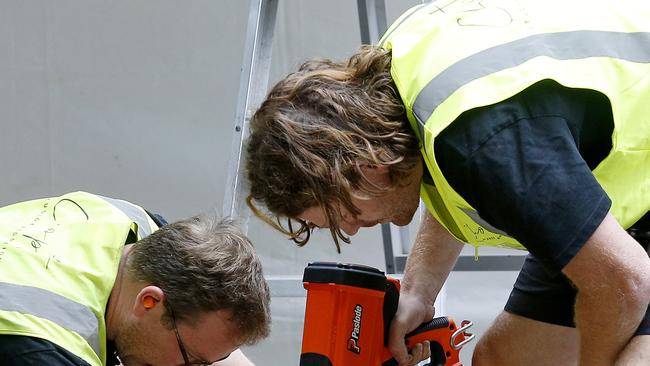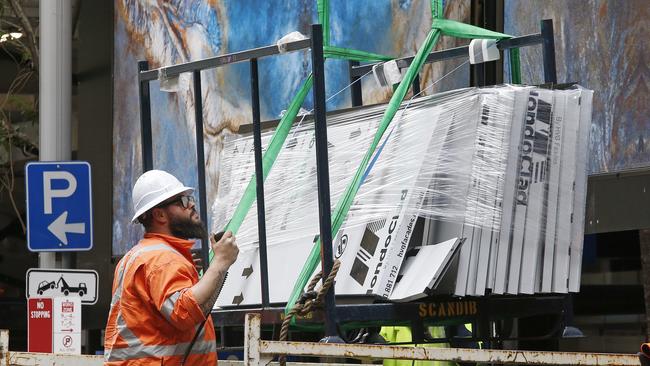Welcome news for the RBA: Wages growth falls in line with inflation
Australia’s wage growth has slowed in the December quarter, which while welcome news for the RBA, shows the peak in earnings growth might be over.

Careers
Don't miss out on the headlines from Careers. Followed categories will be added to My News.
Australian wages rose at the slowest annual pace in more than two years, despite unemployment remaining at historical lows, adding to the chances of future rate cuts.
Fresh data from the Australian Bureau of Statistics on Wednesday showed wages rose by 0.7 per cent in the December quarter 2024, undershooting expectations of a 0.8 per cent growth rate.
Following the weakest quarterly growth rate since 2022, annual wages are now up 3.2 per cent, down from 4.2 per cent in December 2023.

Oxford economics head of macroeconomic forecasting Sean Langcake said today’s ABS data will be welcomed by the RBA.
“Wage pressures are easing, which makes for a softer inflation outlook and goes some way toward justifying yesterday’s rate cut, he said.
“We still expect to see the labour market slacken over 2025, which will take some more heat out of wage growth.”
Private sector wage growth has eased steadily lower over the past year, despite the ongoing tightness in the labour market. Q4 is a quiet period for wage changes, but the average wage change fell to 3.7 per cent.
Mr Langcake said “this suggests workers are losing some bargaining power compared to a year ago.”
Public sector wage growth was modest in Q4 at just 0.6 per cent, although this was partly due to strong wage growth earlier in the year.

AMP economist My Bui said Wednesday’s figures shows wages growth is stabilising.
“Wages growth has declined quickly from its peak, driven by slowing employment markets’ conditions throughout 2023-24 and is clear evidence of the labour market not as red hot as previously feared, despite a low unemployment rate,” she said.
This is despite previous data released by the ABS which shows unemployment is at just 4.0 per cent, well below the national average.
Usually in times of low unemployment, it becomes easier for workers to negotiate higher pay.
“Slowing wages growth does not mean doom and gloom for wage earners though, because inflation has continued to tick down, and real wages growth continues to be positive,” Ms Bui said.
“The improvement in disposable income and purchasing power has underpinned recent improvement in consumer sentiment in Australia.”
“That being said, wages still have a long way to catch up to the cumulative rises in prices over the past few years.”
ABS head of price statistics Michelle Marquardt said the main contributors to the quarterly rises were jobs in health care and social assistance, followed by manufacturing and construction.
“This was the smallest proportion of jobs with a change in wages for the private sector in a December quarter since 2019,” Ms Marquardt said.
“The public sector contributed a quarter of total wage growth, compared to 34 per cent in the December quarter 2023.”

“This drop in contribution was driven by the timing of some agreements shifting to outside the December quarter this year, other agreements have expired or have smaller increases compared to the same time in 2023.”
The ACTU said despite the weaker numbers, real wage growth in the last 12-months grew by more than the entire nine years under the Coalition.
ACTU analysis shows that if wages had continued growing at the slow rate seen under the Coalition, the average Australian worker would experience a pay cut of $3100 a year.
Annual wage growth now sits at 3.2 per cent, compared to average annual wage growth of 2.2 per cent under Coalition governments from 2013 to 2022.
“Workers pay packets in the last 12 months are finally getting ahead of prices and the result is real wages have gone up more in the last year than they did over the entire nine years that Peter Dutton was last in government,” ACTU president Michele O’Neil said.
“Wages don’t just go up by accident – they are the result of campaigns by union members and the Albanese Government making it easier for working Australians to collectively bargain for pay rises, stopping big business wage cutting schemes and lifting the pay of some of the lowest paid workers in Australia.”
Originally published as Welcome news for the RBA: Wages growth falls in line with inflation


